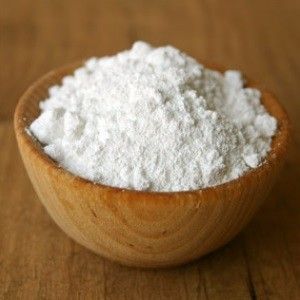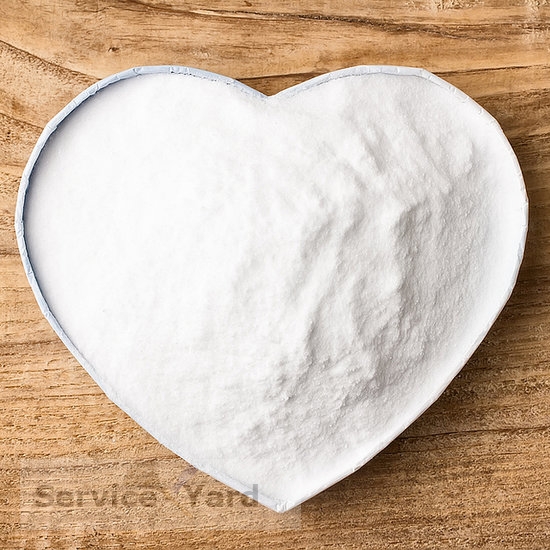Caustic soda

Soda or sodium bicarbonate is familiar to almost everyone, and is widely used in everyday life, due to the mass of excellent properties. Most of us are familiar only with baking soda, but with other sodium compounds: caustic soda and soda ash are not very familiar. All three “sisters” differ in chemical composition and in their properties. In this article we will introduce you to the application, properties, features of each of the above compounds.
to contents ↑Baking soda: application and properties
Baking soda is also called sodium bicarbonate or sodium bicarbonate. The chemical formula of the compound is NaHCO3. This compound has a weak alkaline reaction. Due to its properties, soda can be used not only in everyday life.
Sodium bicarbonate will help improve the taste or fix a damaged dish; it can replace expensive detergents and disinfectants. It will speed up recovery and even help you lose weight. Let's get acquainted with some areas of baking soda use in everyday life.
Cookery
 The traditional use is for baking, as the most common and best baking powder for dough. For splendor and softness, soda is usually quenched with vinegar, kefir or lemon, depending on the recipe. And the use of soda is possible for such purposes:
The traditional use is for baking, as the most common and best baking powder for dough. For splendor and softness, soda is usually quenched with vinegar, kefir or lemon, depending on the recipe. And the use of soda is possible for such purposes:
- Cutlets will be soft and lush if you add a little soda to the minced meat (on the tip of the knife).
- Sodium bicarbonate will speed up the preparation of legumes (peas, beans) if you add a pinch during cooking.
- A small amount of soda neutralizes excess acid in any dish, and the taste of the sauce will become more refined.
- Porridge will not stick to the bottom of the pan if you add a little soda when cooking.
Hygiene and cosmetics
Sodium bicarbonate is an excellent water softener. Aroma oil soda baths are great skin treatments. Due to the change in water hardness, the consumption of gel and soap will decrease, which will positively affect the safety of your budget.
It is also useful to use baking soda at home for such purposes:
- If the hair is quickly greasy, then add the product to the shampoo, and your hair will gain additional volume.
- To get a scrub, apply a little cosmetic milk on a cotton swab and dip it in sodium bicarbonate powder. Using gentle circular motions, walk along the face and neck with the product - the black dots will disappear.
Important! After scrubbing, pamper your face with oily cream.
- Soda is part of homemade toothpaste. Apply sodium bicarbonate powder on the toothbrush with toothpaste to whiten your teeth.
The medicine
The natural antiseptic properties of baking soda allow it to be widely used in traditional medicine to eliminate the symptoms of various diseases. For example:
- Sodium bicarbonate is used to rinse the throat, oral cavity for colds, stomatitis and mucosal damage (prepare a solution of 1 tsp and a glass of water).
- When coughing, add a small amount of soda (on the tip of a knife) to a glass of hot milk. For inhalation, prepare a solution of 1 tsp. funds and a glass of water.
- To get rid of itching after an insect bite, stir a small amount of the product with water until a thick slurry is obtained and apply the medicine to the site of the bite.
- With increased acidity, soda can be taken orally as an antacid (1 teaspoon per ⅓ st. Water).
Important! You can use the tool as a one-time help, with constant use there will be problems with the mucous membrane of the stomach.
- Sodium bicarbonate soften the skin before removing corns and calluses (1 tbsp. L. Funds in 1 l. Of water).
- Soda baths for weight loss and cleansing. To prepare the bath, you need 500 g of sea salt, 300 g of baking soda and 10-15 drops of aromatic oil. The water temperature is 37-39 C, the duration of the procedure is 20 minutes.
Cleaning various surfaces in the house
Baking soda is an excellent cleaning agent that has universal application. Such a cheap powder is perfect for such tasks:
- Perfectly wash sinks, tiles, plumbing.
- It is used for washing and cleaning dishes. Glasses, glasses, glasses, pre-wash soda in cool water, and then rub them to shine will be much easier.
- Perfectly removes the remains of burnt food. In a burnt pan or pan, boil a soda solution (3-4 tbsp. L. Funds in 1 l of water). Leave the dishes for the night, and in the morning everything will be washed off without difficulty.
- The best detergent for cans during preservation - not only ensures perfect cleanliness of the glass, but also prevents the “explosion” of pickles during storage.
- It neutralizes unpleasant odors. For example, to get rid of the smell in the refrigerator: pour a small amount of the product in an open container and place on one of the shelves of the household appliance. Change the powder once every 2-3 weeks.
- Safe detergent for any dishes.
Important! Do not use sodium bicarbonate to clean aluminum objects - it is an exception.
- Easily cope with fresh spots. Soda absorbs fluid very quickly, so blot the stain with paper towels and cover it with soda, and then gently sweep away any remaining dirt with a brush.
- To clean the carpet: Sprinkle sodium bicarbonate powder on the surface, spray the spray gun with water, allow time to dry, and then clean with a vacuum cleaner. After such cleaning, the smell of mustiness will disappear, and the colors will gain brightness.
Soda ash
Soda ash has more alkaline properties and has the following chemical formula Na2CO3. This type of soda was also used by our grandmothers when removing strong contaminants from fabrics and clothes, but this tool is suitable only for linen and cotton materials. It is undesirable to use soda ash for woolen or silk fabrics, since it can ruin the material.
to contents ↑Important! Thanks to its active substances, the product perfectly removes old strong pollution and stains on the stove, plumbing, tile. When adding a calcined product to the powder during washing in automatic machines, the heating elements are protected from the formation of scale.
Caustic Soda: Composition, Properties
 Caustic soda is called sodium hydroxide, sodium hydroxide or sodium hydroxide. The chemical formula of NaOH.
Caustic soda is called sodium hydroxide, sodium hydroxide or sodium hydroxide. The chemical formula of NaOH.
Important! Caustic soda is the most common alkali. The volume of its production and consumption per year is up to 57 million tons.
Properties
Pure sodium hydroxide is an opaque mass of white color, eagerly absorbing not only water vapor, but also carbon dioxide from the air. Caustic sodium interacts with carbon dioxide, which is present in the air: it binds it, and as a result of this interaction, a white precipitate forms over time - soda ash.
Important! Aqueous solutions of caustic soda have a strong alkaline reaction (pH of a 1% solution is 13). When dissolved in water or when diluted with an aqueous solution, as well as when interacting with acids, a lot of heat is released.
You also need to know the following before using caustic soda:
- The product actively reacts with light metals: zinc, magnesium, aluminum, tin, as well as their alloys, releasing a large amount of hydrogen.
- Caustic soda is able to destroy porcelain and glass by leaching of silicates, as well as materials of organic origin, including paper, leather, fabrics, etc. Sodium hydroxide is a corrosive substance.
- The product does not enter into interaction with carbon steel, polyethylene, polyvinyl chloride, chrome-nickel steel, as well as with many rubber-technical materials.
Security:
- Caustic soda, on contact with the skin, causes chemical burns. With prolonged exposure to the skin, ulcers and eczema may appear.
- The product has a strong effect on the mucous membranes; it is especially dangerous if it gets into the eyes. The maximum permissible concentration of aerosol of sodium hydroxide in the air of the working zone of various industrial premises is 0.5 mg per m3.
- Caustic soda is fire and explosion proof. Refers to hazardous substances of the second hazard class according to GOST 12.1.007.
Important! When working with caustic soda, it is imperative to use personal protective equipment: rubber gloves, safety glasses, protective clothing.
Caustic Soda - Industrial Applications
Caustic soda, due to its properties, is widely used in a wide variety of industries, including chemical, metallurgical, gas, petrochemical, pulp and paper, textile, food.
 Here is a far from complete list of all the possibilities of this substance:
Here is a far from complete list of all the possibilities of this substance:
- In the chemical and petrochemical industry (57% of total consumption):
- It is used to neutralize acids and acid oxides.
- Used to clean oil and oil products.
- Using caustic sodium, oil products are produced.
- It is used as a reagent or catalyst in chemical reactions.
- In the pulp and paper industry, caustic is used:
- For delignification of cellulose.
- In the production of paper, cardboard.
- In the production of artificial fibers, wood-fiber boards.
- In the textile industry applies:
- For bleaching fabrics, flax.
- For the regeneration of rubber.
- In the food industry applies:
- For washing and peeling fruits and vegetables.
- In the production of cocoa and chocolate.
- In the production of drinks, ice cream, caramel staining.
- In the production of bakery products, softening olives.
- As a dietary supplement E524.
- At the enterprises of the food industry (creameries, dairies, distilleries, breweries, etc.) it is used to wash industrial equipment, as well as stainless steel and carbon steel pipelines, from oil substances, fat, organic residues. Used for degreasing and handling containers and equipment.
- In construction it is applied:
- In the production of building materials (aerated concrete).
- To strengthen the foundations in buildings and structures.
- In soap making it is used in the manufacture of soap, shampoo and other detergents (for saponification of fats).
- In water treatment processes, caustic is used to neutralize acids and their oxides in water.
- In the military industry:
- It is used as a neutralizer of the most dangerous gas - sarin.
- It is used in an insulating breathing apparatus (rebreather) to purify air from carbon dioxide.
Caustic soda: domestic use
The use of caustic soda in everyday life is also very important, as it allows you to quickly and with minimal effort and money to solve complex pollution problems. For example:
- Cleaning dishes from dirt. Strong and active alkali is able to remove any contaminants from the surface as soon as possible. A burnt pot or pan can be easily cleaned of soot with a caustic solution if left on the surface for a while. Soda ash or baking soda deal with such pollution much more slowly.
Important! Caustic should not be used for aluminum products, as well as Teflon.
- For flushing the heating and sewage systems.Sodium hydroxide is used as a reagent to dissolve clogged sewer pipes. You can use the product in the form of dry granules or as part of gels. Alkali destroys fatty deposits on the walls of pipes, which contributes to the easy movement of blockages further down the drain.
to contents ↑Important! Use caustic with protective equipment only. Store the product only in powder form (in a tightly closed container) and in places inaccessible to children. Do not store caustic as a solution.
Stock footage
We hope that the “miracle remedy” - soda, helped you get rid of many everyday problems easily and simply. Use the information, tips and recommendations for the use of sodium compounds. You will be surprised how much money can be saved on the purchase of completely unnecessary expensive chemical household chemicals, which, moreover, are far from always harmless to humans.
- How to choose a vacuum cleaner taking into account the characteristics of the house and coatings?
- What to look for when choosing a water delivery
- How to quickly create comfort at home - tips for housewives
- How to choose the perfect TV - useful tips
- What to look for when choosing blinds
- What should be running shoes?
- What useful things can you buy in a hardware store
- Iphone 11 pro max review
- Than iPhone is better than Android smartphones



